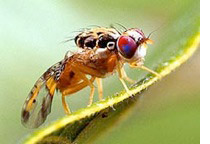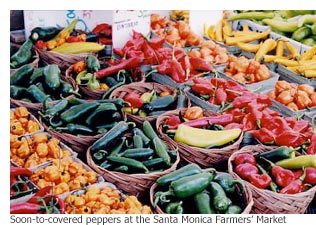Wild females (Medfly variety) crash party
November 23, 2009
 Ah, autumn at the Santa Monica Farmers Market: Heaps of glistening Meyer lemons, crisp Pink Lady apples, fragrant tangerines and guavas, deep orange persimmons…and acres of tulle netting and PVC pipe?
Ah, autumn at the Santa Monica Farmers Market: Heaps of glistening Meyer lemons, crisp Pink Lady apples, fragrant tangerines and guavas, deep orange persimmons…and acres of tulle netting and PVC pipe?
The inedible items on that list are courtesy of some uninvited guests—three wild female Mediterranean fruit flies, two of them sexually mature and “mated.” The flies crashed the Thanksgiving party early at Westside farmers markets, triggering a quarantine that will affect Santa Monica’s four markets and those in 11 other areas for months. In all, 17 certified farmers markets are affected.
That means that farmer-vendors at venues including the Wednesday Santa Monica market—widely regarded as one of the nation’s premier markets, and a must-shop-stop for L.A.’s top chefs—must protect all host fruit while it is on display in the quarantine area. And while they can bring in crops from outside the quarantine area, they can’t bring home unsold fruits and vegetables. Those must be either donated or dumped.
“Sales are going to go down,” says Dolores Cabral of Cabral Farms in Ontario, who sells at Santa Monica’s Saturday market. “People are going to ask questions. I’ve been through those quarantines for many years. It’s a big hassle with the nets.”
 The timing is terrible—this week’s pre-Thanksgiving Wednesday market in Santa Monica is the biggest of the year—but veteran market folks say it’s nothing they can’t handle.
The timing is terrible—this week’s pre-Thanksgiving Wednesday market in Santa Monica is the biggest of the year—but veteran market folks say it’s nothing they can’t handle.
“Fortunately, right now, it’s a fairly small deal,” says Laura Avery, supervisor of the Santa Monica Farmers Markets. “We’ve all been through this. We all know what to do.”
Phil McGrath of McGrath Family Farm in Camarillo, who will be selling produce ranging from heirloom tomatoes to haricot beans, agreed, but said this week’s “Thanksgiving Wednesday,” as it’s known at the market, will have an extra layer of complications on an already demanding day. “We double pick and triple pick items. We know it’s a big day… It’s a food frenzy.”
He said that he did not expect to take an economic hit, however. “We have such a loyal customer base,” McGrath said Tuesday. “The cash customers tomorrow are the truly the heart and soul of our business…There’s the Medfly hassle factor, but I know we’re going to sell out.”
The Medflies were caught Oct. 29 in a Santa Monica backyard in the one of the tens of thousands of traps that Los Angeles County has placed throughout the area. County Agricultural Commissioner Kurt E. Floren told the Board of Supervisors in a letter that day that the immediate area has been treated with hand-sprayed Spinosad bait, an organic product derived from soil bacteria. No aerial spraying is planned.
The quarantine, mapped here by the California Department of Food and Agriculture, affects a 65-square-mile radius from Santa Monica, taking in markets in Pacific Palisades, Venice, Mar Vista, Culver City, Westwood, Westwood Village, Brentwood, Century City, Playa Vista and West Los Angeles, as well as the La Cienega market.
The list of possible host fruits and vegetables that must be covered with tulle netting propped up with PVC piping includes eggplant, tomatoes, bell peppers, apples and avocados, as well as all citrus.
“The farmers are very good. The customers are very supportive. We’re not going to be (aerial) spraying,” Avery says. “The bottom line is nobody wants this bug to spread. The Medfly has never been established in California because of these procedures.”
USDA spokesman Larry Hawkins, who said other Medfly quarantines are currently in effect in San Diego County communities including Fallbrook and El Cajon, said the Santa Monica quarantine is expected to last six months, and possibly longer. He said vigilance is essential because the Medfly is such a destructive bug, known to infest 260 varieties of fruits, nuts and vegetables: “It’s the most significant fruit fly pest on the planet.”
Under quarantine rules, people who grow fruit at home are not allowed to transport it from their property. This state brochure contains other information about how consumers should handle Medfly issues.
County agriculture officials are particularly concerned about travelers bringing in fruit from places like Hawaii and Mexico.
“We don’t know where these Medflies came from this time,” department spokesman Ken Pellman says. “But we need the public’s help in not bringing in fruits, vegetables, and plant material from outside of the state or country unless it has been officially inspected, and not taking those things elsewhere when they are under quarantine.”












 405 bridge work causes a stink
405 bridge work causes a stink
